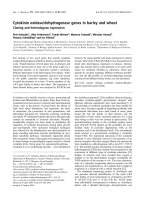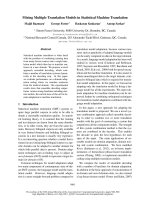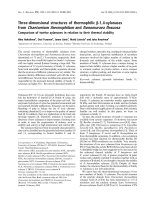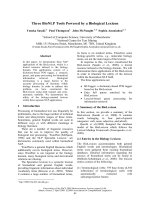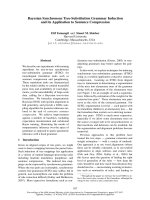Báo cáo khoa học: "Three synchronous primary carcinomas in a patient with HNPCC associated with a novel germline mutation in MLH1: Case report" docx
Bạn đang xem bản rút gọn của tài liệu. Xem và tải ngay bản đầy đủ của tài liệu tại đây (942.34 KB, 6 trang )
BioMed Central
Page 1 of 6
(page number not for citation purposes)
World Journal of Surgical Oncology
Open Access
Case report
Three synchronous primary carcinomas in a patient with HNPCC
associated with a novel germline mutation in MLH1: Case report
Cristian D Valenzuela
1
, Harvey G Moore*
1
, William C Huang
2
,
Elsa W Reich
3
, Herman Yee
4
, Harry Ostrer
3
and H Leon Pachter
1
Address:
1
Department of Surgery, NYU Langone Medical Center, New York, USA,
2
Department of Urology, NYU Langone Medical Center, New
York, USA,
3
Human Genetics Program, NYU Langone Medical Center, New York, USA and
4
Department of Pathology, NYU Langone Medical
Center, New York, USA
Email: Cristian D Valenzuela - ; Harvey G Moore* - ;
William C Huang - ; Elsa W Reich - ; Herman Yee - ;
Harry Ostrer - ; H Leon Pachter -
* Corresponding author
Abstract
Background: MLH1 is one of six known genes responsible for DNA mismatch repair (MMR),
whose inactivation leads to HNPCC. It is important to develop genotype-phenotype correlations
for HNPCC, as is being done for other hereditary cancer syndromes, in order to guide surveillance
and treatment strategies in the future.
Case presentation: We report a 47 year-old male with hereditary nonpolyposis colorectal
cancer (HNPCC) associated with a novel germline mutation in MLH1. This patient expressed a rare
and severe phenotype characterized by three synchronous primary carcinomas: ascending and
splenic flexure colon adenocarcinomas, and ureteral carcinoma. Ureteral neoplasms in HNPCC are
most often associated with mutations in MSH2 and rarely with mutations in MLH1. The reported
mutation is a two base pair insertion into exon 10 (c.866_867insCA), which results in a premature
stop codon.
Conclusion: Our case demonstrates that HNPCC patients with MLH1 mutations are also at risk
for ureteral neoplasms, and therefore urological surveillance is essential. This case adds to the
growing list of disease-causing MMR mutations, and contributes to the development of genotype-
phenotype correlations essential for assessing individual cancer risk and tailoring of optimal
surveillance strategies. Additionally, our case draws attention to limitations of the Amsterdam
Criteria and the need to maintain a high index of suspicion when newly diagnosed colorectal cancer
meets the Bethesda Criteria. Establishment of the diagnosis is the crucial first step in initiating
appropriate surveillance for colorectal cancer and other HNPCC-associated tumors in at-risk
individuals.
Background
Colorectal cancer (CRC) is currently the third leading
cause of cancer and cancer-related deaths in the United
States, estimated to be responsible for 10% of new cancer
cases and 9% of cancer deaths in 2008 [1]. Hereditary
nonpolyposis colorectal cancer (HNPCC), or Lynch syn-
Published: 8 December 2009
World Journal of Surgical Oncology 2009, 7:94 doi:10.1186/1477-7819-7-94
Received: 25 September 2009
Accepted: 8 December 2009
This article is available from: />© 2009 Valenzuela et al; licensee BioMed Central Ltd.
This is an Open Access article distributed under the terms of the Creative Commons Attribution License ( />),
which permits unrestricted use, distribution, and reproduction in any medium, provided the original work is properly cited.
World Journal of Surgical Oncology 2009, 7:94 />Page 2 of 6
(page number not for citation purposes)
drome, is the most common heritable CRC syndrome [2],
accounting for approximately 5% of all CRC cases. Trans-
mitted in an autosomal dominant fashion, HNPCC is
associated with tumorigenesis caused by mutations in one
of several genes involved in DNA mismatch repair (MMR)
[3]. About 90% of HNPCC cases are associated with muta-
tions in MLH1 (OMIM #120436) or MSH2 (OMIM
#609309), and others are associated with mutations in
MSH6, PMS1, PMS2, and MLH3 [4]. Reported MMR
mutations have been catalogued in three online databases
that document the full spectrum of mutations and pheno-
types associated with HNPCC [5-7].
In HNPCC, as in various other cancer syndromes, a
somatic mutation or epigenetic event is needed as the
"second hit" to disable the functional, wild-type allele [8].
Abolition of MMR raises the basal rate of mutation and
leads to microsatellite instability (MSI), a tissue marker of
defective mismatch repair [9]. This increased level of
mutagenesis is most likely to affect tissues that undergo a
high rate of cell division, such as the colonic epithelium
[10]. Carriers of MMR mutations have up to an 82% life-
time risk of developing CRC [11,12]. Aside from demon-
strating an MMR mutation, patients may be clinically
diagnosed with HNPCC if their family cancer history
meets the Amsterdam Criteria II, which encompasses CRC
and associated extracolonic sites [13].
HNPCC also carries the risk of developing cancer at vari-
ous other sites. The most clinically significant extracolonic
cancer associated with HNPCC is endometrial cancer, for
which women have a 60% lifetime risk [11]. Compared to
the general population, patients with HNPCC are 14-fold
more likely to develop urothelial cell carcinoma of the
upper urinary tract, corresponding to a cumulative life-
time risk of 2.6%-4.0% [11,14]. We report the case of a
47-year old man with a rare presentation of two distinct
colorectal adenocarcinomas and a synchronous ureteral
neoplasm. A definitive diagnosis of HNPCC was only
established post-operatively following identification of a
not previously reported germline mutation in MLH1.
Case presentation
A 47-year old man of Puerto Rican descent presented with
recent gross hematuria and a history of lower abdominal
pain of 1-2 years duration. Other comorbidities included
hypertension and Type II diabetes mellitus. He had a 20-
year history of heavy smoking. Colonoscopy three years
prior to presentation revealed no evidence of adenoma-
tous polyps or colorectal cancer.
Urine cytology revealed the presence of numerous red
blood cells, as well as atypical urothelial cells. A subse-
quent CT scan revealed a mass in the mid-right ureter sug-
gestive of a ureteral neoplasm (Fig. 1a). A ureteroscopic
biopsy revealed urothelial mucosa with papillary architec-
ture, suspicious for invasive urothelial cell carcinoma.
Subsequent colonoscopy revealed synchronous tumors in
the ascending colon and splenic flexure (Fig. 1a, b), and
biopsies confirmed both lesions were adenocarcinomas.
A two-centimeter flat lesion was also identified in the
(a) CT scan with PO/IV contrast suggested a large tumor of the ascending colon (arrow)Figure 1
(a) CT scan with PO/IV contrast suggested a large tumor of the ascending colon (arrow). Enlarged pericolic lymph
nodes are suggestive of metastases. Also shown is right-sided hydroureteronephrosis caused by the mid-ureteral tumor
(arrowhead). (b) The colon tumor at the splenic flexure tumor is visible on a different cut (arrow).
World Journal of Surgical Oncology 2009, 7:94 />Page 3 of 6
(page number not for citation purposes)
transverse colon, and biopsy was consistent with a flat
adenoma with focal high-grade dysplasia.
The three tumors were resected in a combined operation,
and the patient recovered from surgery without complica-
tion. The urothelial cell carcinoma was high-grade, pT3
N2 Mx, Stage IV, and the more advanced colon adenocar-
cinoma was moderately differentiated, pT3 N1 Mx, Stage
IIIB. The patient received adjuvant chemotherapy consist-
ing of cisplatin and taxol combined with radiotherapy,
and is disease-free at the time of publication.
A comprehensive family history was taken and a formal
pedigree was assembled (Fig. 2). The patient's father died
of colon cancer shortly after diagnosis at age 55, and three
other paternal family members had cancer in an unknown
site. The patient's paternal grandmother died at an early
age of unknown causes. Four maternal family members
had cancer in unconfirmed sites, and one had acute lym-
phoblastic leukemia.
Although the patient's family history did not satisfy
Amsterdam Criteria II, the early age-of-onset and presence
of synchronous tumors fulfilled the Revised Bethesda Cri-
teria [15]. Immunohistochemistry (IHC) on surgical spec-
imens was as follows: MLH1 stained negative and MSH2
stained positive in all tumors (Fig. 3), strongly suggesting
a mutation in MLH1. Differential staining for cytokeratins
7 and 20 confirmed distinct histological origin of the ure-
teral and colon tumors (Fig. 3). Accordingly, the patient
was referred for genetic counseling and germline muta-
tion testing.
PCR amplification and sequencing on a peripheral blood
sample identified the novel c.866_867insCA MLH1 inser-
tion into exon 10 (Fig. 4). This frameshift mutation is pre-
dicted to produce a truncated, nonfunctional protein
product due to a premature stop codon within exon 10 at
amino acid residue 297. Review of the available databases
revealed this specific mutation had not been previously
reported.
Discussion
There are at least 2200 total variants in the six known
MMR genes, with at least 323 of these reported to be dis-
ease-causing [6]. However, unlike familial adenomatous
polyposis, very little is known about phenotypic variation
as a function of the MMR gene involved or the location
and nature of the specific MMR gene mutation. Hence, it
The patient (proband) is indicated by an arrowFigure 2
The patient (proband) is indicated by an arrow. Age of
diagnosis or death is indicated if known. Diamonds indicate a
group of siblings of unknown sex. Solid boxes indicate a diag-
nosis of colon cancer, and crosshatched boxes indicate can-
cer of non-colorectal origin. A diagonal strikethrough
indicates a deceased individual. Unconfirmed diagnoses of
individuals with extracolonic cancer are noted. Unaffected
members of the extended family have been omitted for con-
ciseness. One family member died in childhood from acute
lymphoblastic leukemia (ALL).
Three immunohistochemical stains (40×) from the patient's ureteral tumor and a selected colon tumorFigure 3
Three immunohistochemical stains (40×) from the
patient's ureteral tumor and a selected colon tumor.
The colon and ureteral cancers stained negative for MLH1
and positive for MSH2. Both colon tumors stained negative
for cytokeratin 7 and positive for cytokeratin 20, whereas
the ureteral tumor stained positive for both cytokeratins,
demonstrating a distinct organ of origin for each tumor type
and thus discounting the possibility that either tumor type is
a metastasis of the other. Data not shown for positive con-
trols.
World Journal of Surgical Oncology 2009, 7:94 />Page 4 of 6
(page number not for citation purposes)
is important to report novel MMR mutations in order to
develop genotype-phenotype correlations and add to the
mutation databases that serve as a reference for genetic
diagnosis.
The history of CRC in the patient's father suggests paternal
origin of the MLH1 mutation. However, the origin of this
mutation cannot be definitively determined, given that
affected paternal family members are deceased and that
the patient's mother declined genetic testing. Further-
more, it remains possible that a de novo mutation may
have occurred in the proband. Nevertheless, the patient's
at-risk siblings have been advised to undergo colonos-
copy, evaluation of the upper urinary tracts and to seek
genetic counseling.
The American Cancer Society (ACS) recommends annual
or biennial colonoscopy for patients diagnosed with
HNPCC by clinical criteria or genetic testing [16]. This
patient's family history did not fulfill Amsterdam Criteria,
and he was therefore not categorized as having HNPCC,
but rather as having increased risk for CRC given a first-
degree relative affected by CRC at age < 60. Thus, the
patient followed the appropriate ACS screening guide-
lines: colonoscopy every 5 years starting at age 40.
Although the revised criteria (Amsterdam Criteria II) are
very specific and more sensitive than the original Amster-
dam Criteria, there are still a substantial number of muta-
tion-positive cases in which the family cancer history does
not satisfy either set of Amsterdam Criteria. Limitations to
obtaining an accurate family history include unavailabil-
ity of original patient records, unrecognized infidelity
within the family, and inaccurate patient recall. Indeed, a
recent prospective population-based study found that
CRC patients being evaluated for HNPCC using the
Amsterdam Criteria were considerably inaccurate when
recalling malignancies of family members: false-negative
and false-positive rates were 39% and 21%, respectively
[17]. This case illustrates the consequences of failing to
recognize a hereditary CRC syndrome, despite following
appropriate surveillance guidelines. Thus, recognition of
newly diagnosed CRC patients that meet Bethesda Criteria
should lead to evaluation with IHC and MSI testing of the
tumor, as well as possible germline testing, despite a fam-
ily history that does not satisfy Amsterdam Criteria. If a
diagnosis of HNPCC is established, at-risk family mem-
bers can be offered genetic testing and begin appropriate
surveillance for HNPCC-associated tumors.
HNPCC patients have an elevated lifetime risk (approxi-
mately 3-4%) of upper urinary tract carcinoma
[11,14,18]. A recent Dutch study found that patients with
MSH2 mutations have a significantly higher risk of upper
urinary tract cancer (12% by age 70, P = < 0.05) compared
to patients with MLH1 mutations, who did not have an
increased risk compared to the general population [19].
Similarly, a British study reported 13 ureteral cancers in
130 HNPCC patients; all were associated with MSH2
mutations [20]. In a Danish study, 11 of 12 ureteral can-
cers were attributable to MSH2 mutations (one was asso-
ciated with a MLH1 mutation) [21]. Taken together, these
studies suggest that the risk of ureteral cancer is elevated
in patients with MSH2 mutations. Our case highlights the
fact that ureteral cancer is also possible in individuals har-
boring MLH1 mutations. Others have reported similar
findings [18]. Further study is necessary to determine
whether surveillance recommendations for urinary tract
cancer in HNPCC should be stratified by the MMR gene
involved.
Specific histological characteristics have been found for
urothelial cell carcinomas associated with HNPCC. Papil-
lary architecture in urothelial cell carcinoma has a sensi-
tivity and specificity of 70% and 78%, respectively, for
predicting MSI [22]. Furthermore, IHC staining detects
the loss of an MMR protein in 78-87% of upper urothelial
cancers with demonstrated MSI [23,24], most commonly
MSH2 and MSH6 [25]. Consistent with our patient, in
HNPCC patients with upper tract urothelial cancers stain-
ing negative for at least one MMR protein, extracolonic
tumors nearly always demonstrated the same MMR stain-
ing profile [25].
Unfortunately, a satisfactory screening test for ureteral
cancer does not currently exist. Although annual urine
cytology is generally recommended for patients with
HNPCC, this test was recently found to have indetermi-
nate sensitivity (29%) for detecting urinary tract cancer in
the setting of HNPCC [21]. In HNPCC kindreds with a
history of ureteral cancer or high-risk mutations, more
aggressive screening may be indicated. In these patients,
Sequence data pertaining to the novel MLH1 mutation found in the probandFigure 4
Sequence data pertaining to the novel MLH1 muta-
tion found in the proband. A two-nucleotide 5'-CA-3'
insertion (box) between base pair positions 866 and 867
leads to nonsense coding of amino acid residues and pre-
dicted truncation of the protein product (c.866_867insCA).
Note: due to the palindromic nature of the insertion site, the
insertion may also be classified as a 5'-AC-3' insertion
between base pairs 867 and 868.
World Journal of Surgical Oncology 2009, 7:94 />Page 5 of 6
(page number not for citation purposes)
routine urinalysis and cytology may be combined with
more contemporary methods of evaluating the upper uri-
nary tract including cystoscopy-ureteroscopy, intravenous
pyelography, ultrasonography, and CT or MR urography
[14]. If suspicion of malignancy remains after cytology
and imaging, FISH (fluorescence in situ-hybridization)
assays may be useful: they can detect upper urothelial cell
carcinomas with a sensitivity of 33% for Grade 1 and
100% for Grade 2 [26]. The two newly-approved commer-
cial FISH assays promise to offer vast improvements over
traditional cytology for detection of upper and lower uri-
nary tract carcinomas of all grades [26].
Conclusion
In patients with a family history characterized by multiple
cases of CRC or extracolonic HNPCC-associated tumors,
the possibility of HNPCC must be considered so that
appropriate surveillance of at-risk individuals can be insti-
tuted. Patients presenting with ureteral cancer, particu-
larly when MSI or suggestive histology is present, should
be referred for colonoscopy as well as genetic risk assess-
ment and possible germline testing. Conversely, in
patients with known HNPCC, ureteral cancer surveillance
is essential. Urine cytology alone appears to be ineffective;
accuracy may be improved with the addition of cross-sec-
tional imaging, ureteroscopic evaluation and FISH analy-
sis. Reporting of novel disease-causing mutations,
including information about ethnicity, is important for
establishing genotype-phenotype correlations. It is antici-
pated that well-defined genotype-phenotype correlations
will facilitate tailoring of surveillance strategies in the
future.
Consent
Written informed consent was obtained from the patient
for publication of this case report and accompanying
images. A copy of the written consent is available for
review by the Editor-in-Chief of this journal.
Competing interests
The authors have no commercial or financial associations
that might create a conflict of interest with the informa-
tion presented in this manuscript.
Authors' contributions
CDV analyzed the data and wrote the first draft of the
manuscript. HGM and HLP are attending surgeons who
conceived the case report. WCH is the attending urologist
who researched urologic tumors in HNPCC. EWR is the
genetic counselor and HO is the medical geneticist who
analyzed the patient's pedigree along with genetic
sequencing data. HY is the attending pathologist who col-
lected and prepared the histological figures. CDV, HGM,
WCH, EWR, HY, HO, and HLP have been involved in
drafting the manuscript and revising it critically for impor-
tant intellectual content. All authors have read and
approved the final manuscript.
Acknowledgements
The authors thank Mark S. Hochberg for guidance and support, Mei X. Peng
for technical assistance, and Melinda Kwan for advice on disease prevalence.
References
1. Jemal A, Siegel R, Ward E, Hao Y, Xu J, Murray T, Thun MJ: Cancer
statistics, 2008. CA Cancer J Clin 2008, 58:71-96.
2. Church J, Simmang C: Practice parameters for the treatment of
patients with dominantly inherited colorectal cancer (famil-
ial adenomatous polyposis and hereditary nonpolyposis
colorectal cancer). Dis Colon Rectum 2003, 46:1001-1012.
3. Guillem JG, Moore HG: Hereditary colorectal cancer and poly-
posis syndromes. In ACS Surgery: Principles and Practice. 2006 revised
edition Edited by: Souba WW, Fink MP, Jurkovich GJ. New York: Web
MD Professional Publishing; 2006:562-572.
4. Lynch HT, de la Chapelle A: Hereditary colorectal cancer. N Engl
J Med 2003, 348:919-932.
5. Woods MO, Williams P, Careen A, Edwards L, Bartlett S, McLaughlin
JR, Younghusband HB: A new variant database for mismatch
repair genes associated with Lynch syndrome. Hum Mut 2007,
28:669-673.
6. InSiGHT: International Society for Gastrointestinal Heredi-
tary Tumors, Mismatch Repair Mutation Database [http://
www.Insight-Group.org]
7. MMR Gene Unclassified Variants Database [http://
www.mmruv.info]
8. Kaz A, Kim YH, Dzieciatkowski S, Lynch H, Watson P, Kay Washing-
ton M, Lin L, Grady WM: Evidence for the role of aberrant DNA
methylation in the pathogenesis of Lynch syndrome adeno-
mas. Int J Cancer 2007, 120:1922-1929.
9. Southey MC, Jenkins MA, Mead L, Whitty J, Trivett M, Tesoriero AA,
Smith LD, Jennings K, Grubb G, Royce SG, Walsh MD, Barker MA,
Young JP, Jass JR, St John DJ, Macrae FA, Giles GG, Hopper JL: Use
of molecular tumor characteristics to prioritize mismatch
repair gene testing in early-onset colorectal cancer. J Clin
Oncol 2005, 23:6524-6532.
10. Radtke F, Clevers H: Self-renewal and cancer of the gut: Two
sides of a coin. Science 2005, 307:1904-1909.
11. Aarnio M, Sankila R, Pukkala E, Salovaara R, Aaltonen LA, de la
Chapelle A, Peltomäki P, Mecklin JP, Järvinen HJ: Cancer risk in
mutation carriers of DNA-mismatch-repair genes. Int J Cancer
1999, 81:214-218.
12. Barrow E, Alduaij W, Robinson L, Shenton A, Clancy T, Lalloo F, Hill
J, Evans DG: Colorectal cancer in HNPCC: Cumulative life-
time incidence, survival and tumour distribution. A report of
121 families with proven mutations. Clin Genet 2008,
74:233-242.
13. Vasen HF, Watson P, Mecklin JP, Lynch HT: New clinical criteria
for hereditary nonpolyposis colorectal cancer (HNPCC,
Lynch syndrome) proposed by the International Collabora-
tive Group on HNPCC. Gastroenterology 1999, 116:1453-1456.
14. Sijmons RH, Kiemeney LA, Witjes JA, Vasen HF: Urinary tract can-
cer and hereditary nonpolyposis colorectal cancer: Risks and
screening options. J Urol 1998, 160:466-470.
15. Julié C, Trésallet C, Brouquet A, Vallot C, Zimmermann U, Mitry E,
Radvanyi F, Rouleau E, Lidereau R, Coulet F, Olschwang S, Frébourg
T, Rougier P, Nordlinger B, Laurent-Puig P, Penna C, Boileau C, Franc
B, Muti C, Hofmann-Radvanyi H: Identification in daily practice of
patients with Lynch syndrome (hereditary nonpolyposis
colorectal cancer): Revised Bethesda guidelines-based
approach versus molecular screening. Am J Gastroenterol 2008,
103:2825-2835.
16. Levin B, Lieberman DA, McFarland B, Andrews KS, Brooks D, Bond
J, Dash C, Giardiello FM, Glick S, Johnson D, Johnson CD, Levin TR,
Pickhardt PJ, Rex DK, Smith RA, Thorson A, Winawer SJ, American
Cancer Society Colorectal Cancer Advisory Group US Multi-Society
Task Force; American College of Radiology Colon Cancer Commit-
tee: Screening and surveillance for the early detection of
colorectal cancer and adenomatous polyps, 2008: A joint
guideline from the American Cancer Society, the US Multi-
Publish with BioMed Central and every
scientist can read your work free of charge
"BioMed Central will be the most significant development for
disseminating the results of biomedical research in our lifetime."
Sir Paul Nurse, Cancer Research UK
Your research papers will be:
available free of charge to the entire biomedical community
peer reviewed and published immediately upon acceptance
cited in PubMed and archived on PubMed Central
yours — you keep the copyright
Submit your manuscript here:
/>BioMedcentral
World Journal of Surgical Oncology 2009, 7:94 />Page 6 of 6
(page number not for citation purposes)
Society Task Force on Colorectal Cancer, and the American
College of Radiology. Gastroenterology 2008, 134:1570-1595.
17. Katballe N, Juul S, Christensen M, Ørntoft TF, Wikman FP, Laurberg
S: Patient accuracy of reporting on hereditary non-polyposis
colorectal cancer-related malignancy in family members. Br
J Surg 2001, 88:1228-1233.
18. Gylling AH, Nieminen TT, Abdel-Rahman WM, Nuorva K, Juhola M,
Joensuu EI, Järvinen HJ, Mecklin JP, Aarnio M, Peltomäki PT: Differ-
ential cancer predisposition in Lynch syndrome: Insights
from molecular analysis of brain and urinary tract tumors.
Carcinogenesis 2008, 29:1351-1359.
19. Vasen HF, Stormorken A, Menko FH, Nagengast FM, Kleibeuker JH,
Griffioen G, Taal BG, Moller P, Wijnen JT: MSH2 mutation carri-
ers are at higher risk of cancer than MLH1 mutation carriers:
A study of hereditary nonpolyposis colorectal cancer fami-
lies. J Clin Oncol 2001, 19:4074-4080.
20. Geary J, Sasieni P, Houlston R, Izatt L, Eeles R, Payne SJ, Fisher S,
Hodgson SV: Gene-related cancer spectrum in families with
hereditary non-polyposis colorectal cancer (HNPCC). Fam
Cancer 2008, 7:163-172.
21. Myrhoj T, Andersen MB, Bernstein I: Screening for urinary tract
cancer with urine cytology in Lynch syndrome and familial
colorectal cancer. Fam Cancer 2008, 7:303-307.
22. Hartmann A, Dietmaier W, Hofstadter F, Burgart LJ, Cheville JC,
Blaszyk H: Urothelial carcinoma of the upper urinary tract:
Inverted growth pattern is predictive of microsatellite insta-
bility. Hum Pathol 2003, 34:222-227.
23. Hartmann A, Zanardo L, Bocker-Edmonston T, Blaszyk H, Dietmaier
W, Stoehr R, Cheville JC, Junker K, Wieland W, Knuechel R, Rue-
schoff J, Hofstaedter F, Fishel R: Frequent microsatellite instabil-
ity in sporadic tumors of the upper urinary tract. Cancer Res
2002, 62:6796-6802.
24. Catto JW, Azzouzi AR, Amira N, Rehman I, Feeley KM, Cross SS,
Fromont G, Sibony M, Hamdy FC, Cussenot O, Meuth M: Distinct
patterns of microsatellite instability are seen in tumours of
the urinary tract. Oncogene 2003, 22:8699-8706.
25. Ericson KM, Isinger AP, Isfoss BL, Nilbert MC: Low frequency of
defective mismatch repair in a population-based series of
upper urothelial carcinoma. BMC Cancer 2005, 5:23.
26. Tetu B: Diagnosis of urothelial carcinoma from urine. Mod
Pathol 2009, 22(Suppl 2):53-59.

